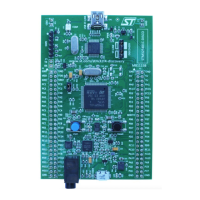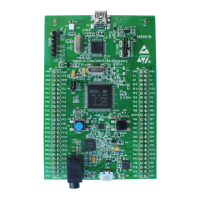Serial peripheral interface/ inter-IC sound (SPI/I2S) RM0402
848/1163 RM0402 Rev 6
26.6.6 I
2
S slave mode
The I
2
S can be configured as follows:
• In slave mode for transmission or reception (half-duplex mode using I2Sx)
• In slave mode transmission and reception (full-duplex mode using I2Sx and I2Sx_ext).
The operating mode is following mainly the same rules as described for the I
2
S master
configuration. In slave mode, there is no clock to be generated by the I
2
S interface. The
clock and WS signals are input from the external master connected to the I
2
S interface.
There is then no need, for the user, to configure the clock.
The configuration steps to follow are listed below:
1. Set the I2SMOD bit in the SPIx_I2SCFGR register to select I
2
S mode and choose the
I
2
S standard through the I2SSTD[1:0] bits, the data length through the DATLEN[1:0]
bits and the number of bits per channel for the frame configuring the CHLEN bit. Select
also the mode (transmission or reception) for the slave through the I2SCFG[1:0] bits in
SPIx_I2SCFGR register.
2. If needed, select all the potential interrupt sources and the DMA capabilities by writing
the SPIx_CR2 register.
3. The I2SE bit in SPIx_I2SCFGR register must be set.
Transmission sequence
The transmission sequence begins when the external master device sends the clock and
when the NSS_WS signal requests the transfer of data. The slave has to be enabled before
the external master starts the communication. The I
2
S data register has to be loaded before
the master initiates the communication.
For the I
2
S, MSB justified and LSB justified modes, the first data item to be written into the
data register corresponds to the data for the left channel. When the communication starts,
the data are transferred from the Tx buffer to the shift register. The TXE flag is then set in
order to request the right channel data to be written into the I
2
S data register.
The CHSIDE flag indicates which channel is to be transmitted. Compared to the master
transmission mode, in slave mode, CHSIDE is sensitive to the WS signal coming from the
external master. This means that the slave needs to be ready to transmit the first data
before the clock is generated by the master. WS assertion corresponds to left channel
transmitted first.
Note: The I2SE has to be written at least two PCLK cycles before the first clock of the master
comes on the CK line.
The data half-word is parallel-loaded into the 16-bit shift register (from the internal bus)
during the first bit transmission, and then shifted out serially to the MOSI/SD pin MSB first.
The TXE flag is set after each transfer from the Tx buffer to the shift register and an interrupt
is generated if the TXEIE bit in the SPIx_CR2 register is set.
Note that the TXE flag should be checked to be at 1 before attempting to write the Tx buffer.
For more details about the write operations depending on the I
2
S Standard-mode selected,
refer to
Section 26.6.3: Supported audio protocols.

